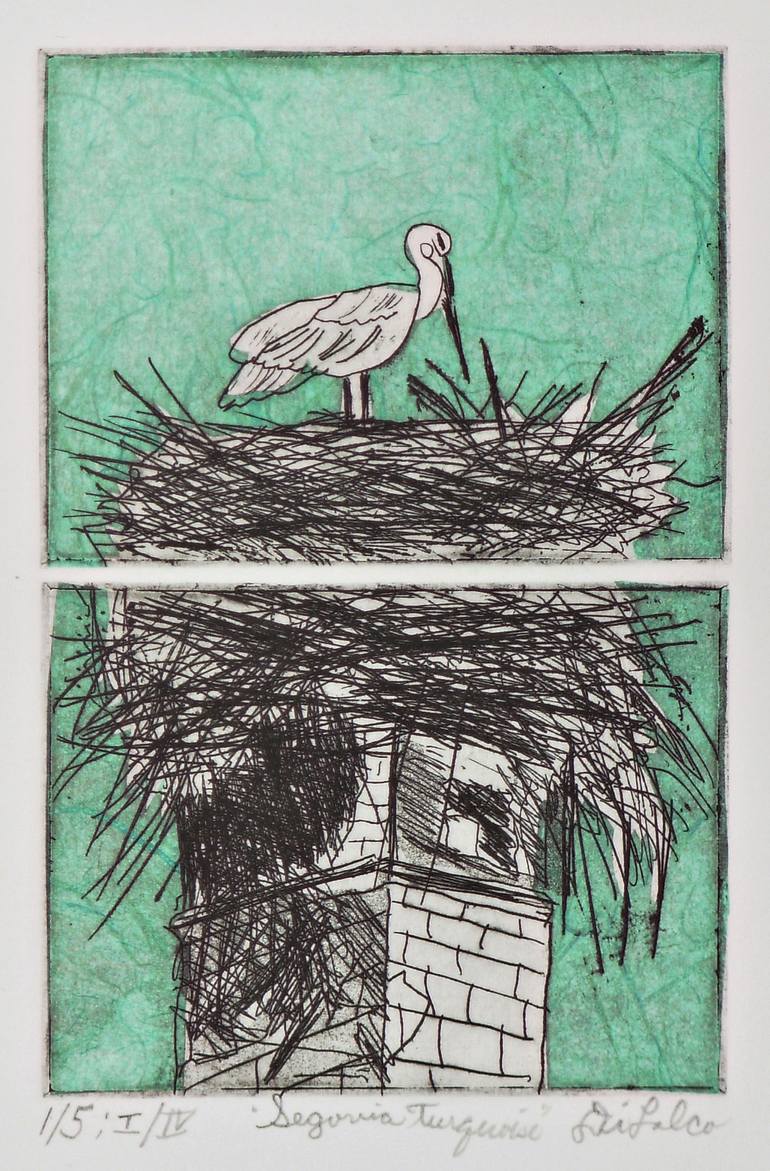


VIEW IN MY ROOM
STORK TURQUOISE - Limited Edition 1 of 4 Print
United States
Printmaking, Aquatint on Paper
Size: 8 W x 10 H x 1 D in
Ships in a Box
Artist Recognition

Artist featured in a collection
About The Artwork
This original hand printed etching (aquatint, intaglio, Chine collè) was based on a photograph taken by the artist in Segovia, Spain (1990). To see a stork nesting on a roof chimney is a common sight in Segovia, Spain. The artist captured this image very close to the ancient Roman aqueduct; the nesting bird had settled on a friend’s restaurant that is noted for it baby suckling pig roasted on a woof-fired oven. It is executed on two zinc plates to give the illusion of looking at the scene through a window. Each plate is 4 inches by 3inches high, making the overall image 4 inches wide by 6.20 inches high (or about 10 by 16 cm). This is print number one of the first edition of four editions; each edition is limited to only five etchings. Published by the artist at The Center for Works on Paper, 705 Christian Street in Philadelphia, Pennsylvania, US. Oil-based ink from Paris on RivesBFK white paper (also French); the mulberry bark paper used in the Chine collè process was made in Thailand and infused with kozo threads from Japan. Homemade methylcellulose was used to treat the mulberry bark paper. NOTE: This work is sold with a frame (10 X 8 INCHES); Price includes shipment costs.
Details & Dimensions
Printmaking:Aquatint on Paper
Artist Produced Limited Edition of:5
Size:8 W x 10 H x 1 D in
Frame:Not Framed
Ready to Hang:Not applicable
Packaging:Ships in a Box
Shipping & Returns
Delivery Time:Typically 5-7 business days for domestic shipments, 10-14 business days for international shipments.
Handling:Ships in a box. Artists are responsible for packaging and adhering to Saatchi Art’s packaging guidelines.
Ships From:United States.
Have additional questions?
Please visit our help section or contact us.
United States
Imagery and storyline—both vital components of my creative process—enable me to create a form of visual poetry. Consequently, photography is intricate to my artistic strategy, especially with regard to my etchings. In view of this, many of my printed images—accomplished via the studio techniques of intaglio, aquatint, drypoint, and Chine collè—originate from my own photographs, as well as ones I uncover during research into the archives of academia, historical societies, and museums. Upon locating a scene that fascinates me, I first sketch a few original drawings of the likeness, and next transfer that drawing onto my prepared zinc etching plate. NOTE: In my etchings that incorporate the Chine collè process, I use mulberry bark paper from Thailand, which is infused with Japanese kozo threads. The paper is also treated with methylcellulose. I endeavor to establish links between the metaphysical and physical worlds . . . between the realms of dream and reality . . . and between the natural and the fabricated. In a sense, I believe that art unveils everything that we mask behind our assumptions and biases . . . or rather, those realms we neglect—or refuse—to perceive. My label for our failure to examine these areas is, “The Phenomenology of Non-Connectedness", which I blame on today’s communicational tools such as Social Media, the Internet, texting on smart phones, and “tweeting”. MY ETCHING TECHNIQUE I work on metal etching plates treated with both hard and soft grounds. These grounds consist of mineral spirits, beeswax, oil of spike lavender, and other natural substances. After these grounds dry, I draw images with needles and other tools onto the plate. Next, the exposed areas are “etched into” the zinc or copper plate in a bath of Nitric Acid and spring water. An artist’s proof in then printed after the plate is cleaned; Moreover, two to seven additional plate workings, acid baths, and proof printings occur before my desired effect is obtained. When satisfied with my end result, I apply oil based etching ink onto the clean plate and then remove the excess ink with several wipes. Next, I align my etching plate onto the printing press bed and cover it with papers and press blankets. Finally, the plate goes through the press to obtain my print. This process is repeated until all editions are created. I usually create three to five editions of five or six etchings for each one of my plates.
Artist Recognition

Artist featured by Saatchi Art in a collection
Thousands Of Five-Star Reviews
We deliver world-class customer service to all of our art buyers.
Global Selection
Explore an unparalleled artwork selection by artists from around the world.
Satisfaction Guaranteed
Our 14-day satisfaction guarantee allows you to buy with confidence.
Support An Artist With Every Purchase
We pay our artists more on every sale than other galleries.
Need More Help?